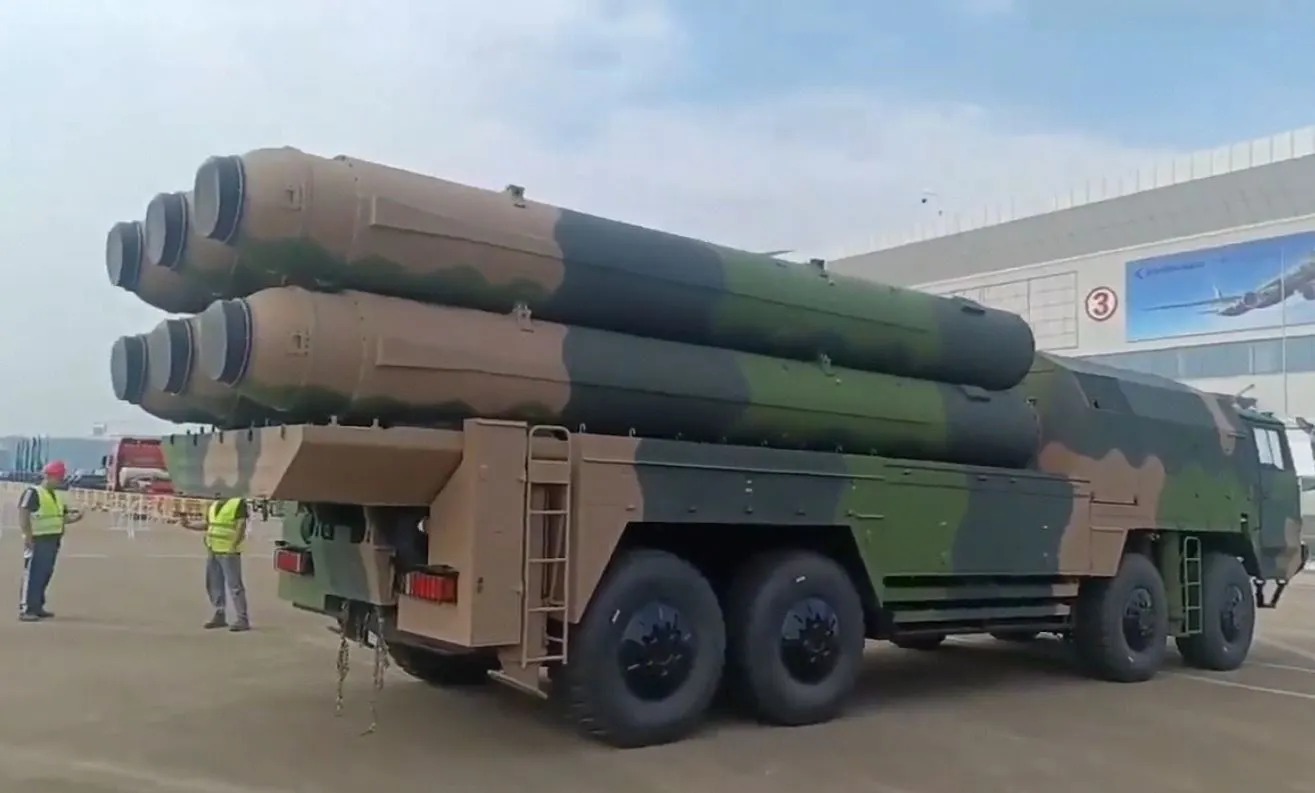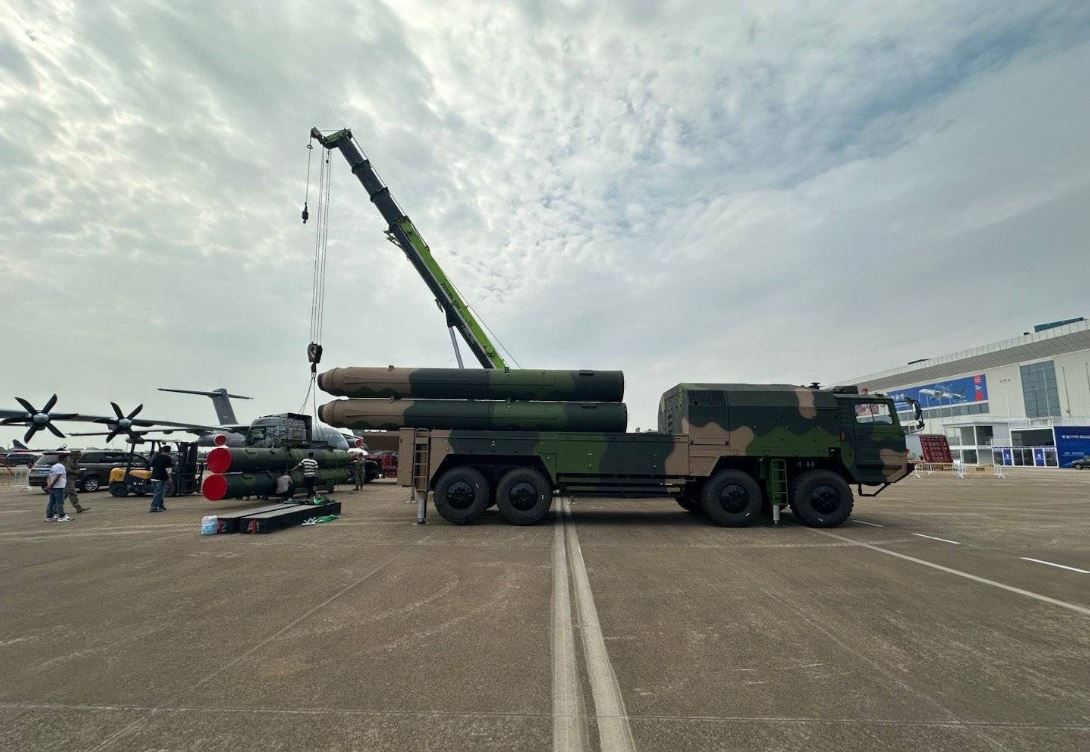As global attention remains hinged on the Chinese fifth-generation J-35A stealth fighter jet, Beijing will debut another major military platform at the upcoming Zhuhai Air Show—the HQ-19 anti-ballistic missile defense system, rumored to be the Chinese alternative to the US Terminal High Altitude Air Defense (THAAD) system.
The anti-ballistic missile defense system will be on static display at the upcoming Zhuhai Air Show, which will run from November 12 to 17. The state-owned Chinese publication Global Times reported that it will be accompanied by the new J-35A stealth aircraft and a new-type armed reconnaissance drone.
The images of the HQ-19 appeared on social media site X (formerly Twitter) on November 5, with several dedicated PLA watchers and experts declaring that the HQ-19 would be the biggest highlight of the Zhuhai Air Show.
A popular PLA watcher, Rick Joe, wrote on X: “If this thing is indeed HQ-19 and the ABM system that’s been rumored for many years (one of many ABM systems), shown at Zhuhai, I’d rank this above J-35A in terms of significance.”
In addition to the images of the HQ-19 launcher posted on X, a picture of an HQ-19 sign has also surfaced. The placard read: “The HO-19 is a new-generation surface-to-air missile independently developed by China which is mainly deployed to intercept ballistic missiles invading the region. It has the characteristics of large combat-protection coverage, strong penetration, and countermeasure capabilities. HQ-19 is the cadre equipment air-defense and anti-missile operations in China.”
According to reports, the HQ-19 was first tested in 2021 and has likely entered service. This system is presumably designed for the exoatmospheric interception of ballistic missiles and will operate as the mid-tier of the Chinese Ballistic Missile Defense (BMD) layered system, according to a host of speculations.
While the details of the system remain classified, the range of HQ-19 is speculated to be between 1,000 to 3,000 kilometers. This has led military analysts to position the HQ-19 as an alternative to the US THAAD, which can acquire and track targets up to 3,000 kilometers away when in its forward-based mode. As per speculation, the HQ-19 likely uses the “hit-to-kill” technology, which is typical for US interceptor missiles.

The EurAsian Times understands that these are all mere speculations due to the paucity of details. Chinese military programs typically remain shrouded in secrecy.
A PLA watcher, Hurin, predicted, “HQ-19 is The Biggest highlight of Zhuhai so far, along with J-35A. Nations will literally beg for such ADS, but whether they offer it remains to be seen.”
Earlier, the US Defense Department’s annual assessments of China’s military capabilities for 2020 and 2021 noted that China is building its homegrown CH-AB-X-02 (HQ-19) surface-to-air missile (SAM) system, which will probably be able to defend against ballistic missiles without giving further details.
Later, some Pentagon sources said that the HQ-19 is likely to be a mid-course interceptor. The mid-course phase of the missile is sandwiched between the boost and terminal phases and is considered to be the most challenging for interception. Since the mid-course phase lasts the longest of the three stages of a missile’s flight, the defending side can shoot multiple interceptors against the incoming missile.
However, the exo-atmospheric conditions in space and the speeds involved in mid-course intercepts are difficult to master, as previously explained in a detailed EurAsian Times article that can be read here.
On two occasions—June 2022 and April 2023—China announced that it had successfully tested a mid-course ground-based missile interceptor, which piqued the interest of observers.
On both occasions, there were speculations that it could be the HQ-19. However, none of them could be verified. Eurasian Times understands that China is working on multi-anti-ballistic missile defense systems to bolster its defenses and prepare for potential combat with the United States.
With the latest HQ-19 system set to debut at the Zhuhai Air Show next week, more details are expected to emerge shortly.

China’s Upcoming Zhuhai Air Show
The Zhuhai Airshow China 2024 is scheduled from November 12 to 17 in Zhuhai, South China’s Guangdong Province. This will be the fifteenth edition of the Chinese Air Show, which coincides with the 75th anniversary celebrations of the PLA Air Force.
This Air Show 2024 will be a special event for a host of reasons, including the debut of China’s latest stealth aircraft—the J-35A. With the official commissioning of this aircraft, China will become only the second country in the world to operate two different fifth-generation stealth fighter jets.
In an official announcement, the PLAAF said that it will bring 36 different types of equipment for aerial flight demonstrations and ground static displays, flaunting the development of its equipment in a thorough and up-close manner.
According to the PLA Air Force, 26 aircraft of seven different classes, including the J-20 stealth fighter jet, J-16 multirole fighter jet, and YU-20A tanker aircraft, would perform in flight alongside the Bayi and Red Falcon aerobatic teams.
Additionally, the service announced that the Y-20 transport aircraft’s cargo compartment would be accessible for viewing, and bookings would be made through a lottery system.
Notably, 1,022 companies from 49 countries are expected to participate in the event. Moreover, ahead of the air show, the Russian Su-57 fifth-generation stealth aircraft and an An-124 large transport aircraft arrived in China, further driving the excitement.
As the biggest biennial air show in the country, the event draws massive crowds of spectators who witness the impressive display of China’s military and commercial aircraft.
In September this year, Lieutenant General Yu Qingjiang, the Vice Commander of the PLA Air Force, said the PLAAF would showcase its capabilities in air combat, air strikes, unmanned and counter-unmanned warfare, strategic delivery and airdropping, early warning, and air defense using new equipment publicly displayed for the first time.
- Contact the author at sakshi.tiwari9555 (at) gmail.com
- Follow EurAsian Times on Google News




